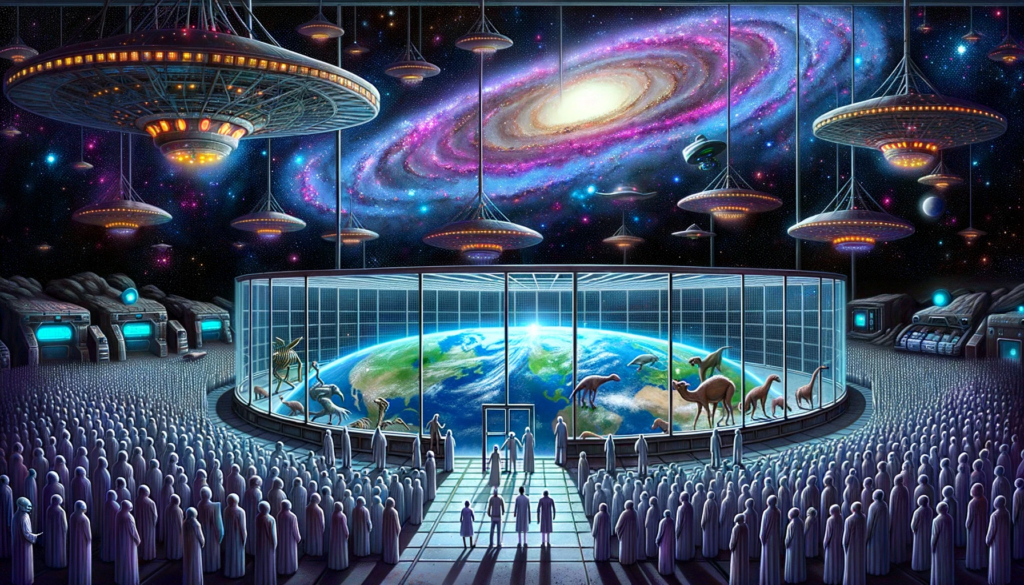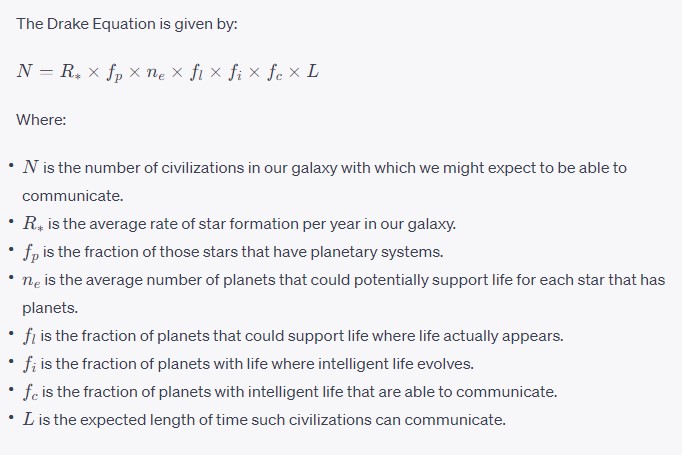Plunge into the vast universe of the Fermi Paradox, an interstellar travel-related puzzle rooted in Enrico Fermi’s profound question: “Where is everybody?” This paradox delves into the glaring contradiction between the high probability of intelligent aliens on exoplanets and our lack of evidence or contact despite advances in space travel. It’s like having an unbounded growth of solar system resources, an endless supply of free power, but only a finite amount to use.
The significance of this paradox, involving exoplanets, interstellar travel, singularity, and extraterrestrial civilizations, extends beyond astrobiology. It reaches into philosophical realms and challenges our understanding of existence itself. So gear up for a galactic exploration that stretches your mind as much as it does the fabric of our galaxy’s space-time itself, revealing exoplanets through advanced technology.
Analyzing the Drake Equation
Grasping the Drake Equation
The Drake Equation is an attempt to estimate the number of civilizations with intelligent life on exoplanets in our galactic neighborhood of the Milky Way. It’s not a crystal ball, but more like a statistical tool employing probability, leveraging technology, utilizing numbers on a time scale.
This equation came from Frank Drake in 1961. The idea was not designed to provide a precise count of the population, but rather to stimulate scientific dialogue among researchers about interactions. And boy, did it deliver!
Unpacking Key Variables
| Variable | Value | Unit |
|---|---|---|
| Rate of star formation | 1.5-3 | stars/year |
| Fraction of stars with planets | 0.2-0.5 | (20%-50%) |
| Average number of planets per star | 1-5 | planets/star |
| Fraction of planets that could support life | 0.1-0.5 | (10%-50%) |
| Fraction where intelligent life evolves | 0.1-0.5 | (10%-50%) |
| Lifetime of technologically advanced civilizations | 1,000-100,000 | years |
Source: Adapted from various astronomical researches, including studies from NASA and SETI Institute.
The equation uses variables such as the rate of star formation in the galaxy, the fraction with planets, the population of stars, and the likelihood of intelligent life and its evolution.
-
The rate of star formation in the Milky Way considers how many stars form each year, impacting the galaxy’s population and time scale of evolution.
-
The fraction with planets looks at what percentage of stars in our galaxy, the Milky Way, have planetary systems potentially harboring intelligent life population.
-
The likelihood of intelligent life, or technologically advanced species in various civilizations, is all about assessing how often such species could develop intelligence similar to or beyond humans, utilizing their resources.
These factors are pivotal in our interactions as they help us assess where we might find intelligent life, like ET (extraterrestrial) buddies, by using intelligence to search the star systems.
Criticisms and Limitations
Like any model, the Drake Equation in galaxy studies isn’t without its critics and limitations, especially in terms of technology usage and radio signal interactions. Some argue that human understanding of the galaxy is too speculative; others say it oversimplifies complex cosmic phenomena over time, despite evidence.
One major criticism lies in its variables. Galaxies are challenging to pin down accurately on a trajectory due to our limited human understanding of the universe and radio signals. For instance:
-
We don’t know exactly how often life, akin to human civilizations, awakens over time on other planets.
-
We’re unsure about how frequently intelligent human civilizations develop and harness energy when life does arise over the years.
Another limitation is that this equation assumes radio communication desires among human civilizations in cities, factoring in energy usage. But who’s to say alien civilizations would want to chat with human societies via radio, from their cities?
Unpacking the Great Filter Theory
A Primer on the Great Filter
The ‘Great Filter’, much like radio in its time, is not your everyday coffee shop accessory in most cities, often leading to burnout. It’s a hypothetical roadblock, a cosmic barrier impacting the trajectory of civilizations over time, a force that puts a full stop to cities harnessing energy to take over galaxies.

This energy-focused theory is a cog in the trajectory of civilizations’ wheel in the Fermi Paradox, often discussed on radio. In essence, it seeks to explain why we haven’t yet detected any radio signals or signs of energy use from extraterrestrial civilizations in our time.
Has Humanity Passed The Filter?
Now here’s where things get interesting. Have we already passed this time filter or are we yet to face the burnout of civilizations, echoing like a radio?
Some optimists argue that we’ve already crossed this hurdle. They believe that life itself, akin to civilizations over time, is rare and complex enough to be considered as one such filter, an energy-intensive process prone to burnout.
If they’re right, then cities might just be one of the few (or only) civilizations in our galaxy experiencing energy-driven growth over time. Kinda makes you feel special, doesn’t it?
However, others aren’t so sure.
Are We Yet To Encounter The Great Filter?
A significant chunk of thinkers believe that humanity, through its various civilizations and cities over time, hasn’t encountered the great filter yet, even amidst burnout. If they’re correct, then our civilizations’ future might be filled with energy challenges and growth burnout that could potentially wipe us out entirely.
These could range from self-inflicted disasters like nuclear wars, environmental degradation causing burnout of energy resources, to external threats like asteroid impacts or deadly cosmic events threatening the growth of civilizations.
Either way, if these folks studying civilizations and energy growth are right, then there’s some serious soul-searching needed to avoid burnout in our survival strategy!
Implications For Human Civilization
Depending on where this great filter of civilizations lies has profound implications for our energy growth and potential burnout, especially for us humans.
If we have indeed passed the phase of burnout and energy deficit in our civilizations, then maybe we can experience growth and breathe easy (at least for now). Our energy-driven civilizations would likely continue to progress technologically and explore galaxies far beyond our own without much existential dread.
But if the filter still lies ahead? Well… let’s just say energy shortages could make civilizations get real rough, real quick!
In fact, some scientists studying ancient civilizations even suggest that finding microbial life or energy sources on Mars or any other planet would be a bad sign. This would imply that civilizations aren’t as rare as we thought, and the energy filter might still be ahead of us.
So, should we hope to find little green men or signs of ancient civilizations on Mars, perhaps powered by unique forms of energy? Or pray it remains a barren wasteland? I’ll leave that for you to ponder upon!
Theories on Extraterrestrial Life’s Rarity
Diving into the cosmos, we’re going to examine the energy requirements of the Rare Earth Hypothesis, explore theories about energy consumption in hostile environments, and consider whether advanced civilizations self-destruct due to energy depletion before making interstellar contact.
The Rare Earth Hypothesis
The Rare Earth Hypothesis suggests that complex civilizations and life require unique energy conditions. It’s not just about having a habitable world with civilizations; it’s about having the right kind of energy in the world. For instance:
-
Stable star systems: Not every star is as stable as our sun, providing consistent energy to civilizations.
-
Right elemental ingredients: Elements like carbon and oxygen are vital for life as we know it, fueling energy production and supporting civilizations.
-
Galactic positioning of civilizations: Being in a safe, energy-efficient neighborhood of the galaxy matters.
This hypothesis implies that intelligent alien civilizations might be rarer than we think, particularly in terms of energy usage.
Hostile Environments Limiting Survival
Space is a tough neighborhood. Exoplanets can have hostile environments which could limit the development or survival of extraterrestrial civilization and energy sources. These include:
-
Extreme temperatures: Too hot or too cold can make survival impossible for both energy systems and civilization.
-
Lack of water: Water, like energy, is critical for known forms of life and civilization.
-
High radiation levels in civilization can damage DNA and other biological molecules.
These factors suggest that even if alien species exist, they might struggle to thrive or evolve into intelligent beings capable of interstellar travel.
Self-destruction Before Interstellar Contact
Finally, let’s ponder a darker theory. Could advanced civilizations self-destruct before making contact with others? Some reasons could be:
-
Technological singularity: Rapid technological advancement could lead to uncontrollable outcomes.
-
Resource depletion: Overconsumption might lead to societal collapse.
-
Warfare or conflict: Advanced weapons could wipe out entire civilizations.
If true, this theory would mean there are plenty of civilizations out there in the observable universe but they just don’t last long enough to reach us (or vice versa).
Explored Hypotheses for the Paradox
The Fermi Paradox is a complex conundrum that’s had scientists scratching their heads for decades. Let’s dive into some of the most intriguing hypotheses proposed to explain this paradox.
The Zoo Hypothesis

First up, we have the Zoo Hypothesis. This idea suggests that other civilizations might be intentionally leaving us alone, like animals in a zoo.
They’re watching from afar, perhaps even sending probes to monitor our progress. It’s a wild thought, isn’t it? But it’s not entirely outlandish.
Consider how we treat uncontacted tribes on Earth – we observe from a distance, but don’t interfere with their development. Could advanced extraterrestrial life be doing the same with us?
Transcension Hypothesis Evaluation
Next on our list is the Transcension Hypothesis. This theory proposes an alternative perspective – advanced species aren’t expanding outwardly; they’re disappearing inwardly.

Imagine civilizations so advanced that they transcend our physical universe, moving into black holes or even creating their own pocket universes. Mind-blowing stuff!
This hypothesis suggests that space exploration might not be the endgame for all species. Some may evolve beyond our comprehension and leave no trace of their existence in our observable universe.
Reviewing Simulation Hypothesis
Finally, let’s take a look at the Simulation Hypothesis – one of my personal favorites! This hypothesis posits that our reality could just be an elaborate simulation created by higher beings.

Think about how far video game technology has come in just a few decades. Now imagine what an advanced civilization could create after millions or billions of years of technological progression!
Could we simply be characters in someone else’s video game? Or are we part of some cosmic experiment conducted by entities beyond our understanding? The possibilities are as infinite as the worlds within this paradoxical universe.
Potential Resolutions: Current Research
Search for Extraterrestrial Intelligence
SETI, or the Search for Extraterrestrial Intelligence, is a collective term for ongoing scientific research projects aiming to detect intelligent extraterrestrial life. These researchers are using radio and optical telescopes to search for signals from outer space.
-
SETI’s efforts have been ramped up over the years.
-
They’re now using AI to analyze data faster.
But here’s the kicker: despite decades of searches, no contact has been made. Yet, scientists remain hopeful about possible means of making contact in the future.
Technology Aiding Exploration
Advancements in technology have significantly impacted our exploration capabilities. The Kepler Space Telescope and James Webb Space Telescope are two such examples.
-
Kepler has discovered thousands of exoplanets since its launch.
-
The James Webb Space Telescope will allow us to peer into the universe like never before.
These technological wonders provide us with valuable information about potential life-sustaining planets beyond our solar system.
Bio-signatures and Techno-signatures
Researchers are also delving into bio-signatures and techno-signatures as potential evidence for extraterrestrial life. Bio-signatures refer to substances showing signs of life, while techno-signatures indicate technologically advanced civilizations.
-
Scientists have found possible bio-signature gases on Venus.
-
Techno-signatures could include large-scale energy consumption or artificial structures visible from space.
The possibility of finding these signatures keeps scientists motivated in their search for extraterrestrial intelligence.
The Fermi Paradox in Culture
We’re about to delve into how the Fermi Paradox has shaped our culture, influencing everything from science fiction literature and films to philosophical debates on human existence. Fasten your seatbelts, folks!
Sci-Fi Literature and Films Influence
The Fermi Paradox has had a profound impact on science fiction literature and films. It’s been the muse for many a storyteller.
For instance, take Arthur C. Clarke’s “2001: A Space Odyssey”. The concept of intelligent civilizations beyond our own is central to its plot.
In film, Steven Spielberg’s “Close Encounters of the Third Kind” grapples with potential contact with extraterrestrial life. It presents an advanced civilization reaching out to us, mirroring the paradox’s question: “Where is everybody?”
Philosophical Debates Stirred
Philosophers have also found fertile ground in the Fermi Paradox. It triggers existential questions about our place in the universe.
Some argue that if there are other technological civilizations out there, it challenges our uniqueness as a species. Others counter-argue that maybe we’re alone in this entire galaxy or even beyond – making us incredibly special.
These debates resonate with society at large as they touch upon fundamental aspects of human existence.
Cultural Shifts Anticipated
The potential discovery or contact with extraterrestrial life could bring about significant cultural shifts.
Imagine for a moment if we found proof of another civilization in our Milky Way. Our perception of ourselves would be forever altered – we’d realise we aren’t alone in this vast star system.
This realization could lead to changes on multiple levels – from how societies function to individual worldviews. We might see more emphasis on global cooperation, realizing that we’re all part of one global civilization amidst potentially numerous others across the stars.
Summarizing Insights
The Fermi Paradox is more than just a dinner party conversation starter—it’s a testament to our relentless pursuit of understanding, a symbol of our curiosity that extends beyond earthly confines. The paradox, with its myriad theories and hypotheses, showcases humanity’s strength in grappling with the unknown. It reminds us that it’s okay not to have all the answers yet; after all, the journey of discovery is often as enlightening as the destination itself.
So keep pondering, keep asking those big questions. Who knows? Maybe one day, you’ll be part of unraveling this cosmic mystery. And while we wait for that day, let’s continue exploring and learning—about the universe, about ourselves. After all, every bit of knowledge gained brings us one step closer to answering Fermi’s poignant question: “Where is everybody?”
FAQs
What is the Fermi Paradox?
The Fermi Paradox refers to the contradiction between high probability estimates for extraterrestrial life and humanity’s lack of contact or evidence for such civilizations.
What are some theories related to the Fermi Paradox?
There are numerous theories related to this paradox including The Drake Equation (a mathematical formula used to estimate the number of advanced civilizations in our galaxy), The Great Filter Theory (a hypothetical barrier which prevents civilizations from colonizing other planets), among others.
How does current research help solve the Fermi Paradox?
Current research in astrobiology and astronomy helps us understand more about conditions necessary for life and how common these might be in our universe. This could potentially help resolve aspects of the paradox.
What impact does culture have on our understanding of Fermi’s Paradox?
Culture influences how we perceive and interpret phenomena like the Fermi Paradox. Literature, movies, music often reflect societal views on extraterrestrial life and can shape discussions around it.
Is there any definitive solution to the Fermi Paradox?
As of now, there is no definitive solution to the Fermi Paradox. It remains one of the biggest mysteries in science and continues to inspire research and exploration.
Table: Overview of Extraterrestrial Exploration and Hypotheses
| Metric/Aspect | Estimated Value/Description |
|---|---|
| Number of Known Exoplanets | ~4,500 (as of 2022) |
| Stars in the Milky Way with Planetary Systems | 20-50% |
| Civilizations Estimated by Drake Equation | Varies widely (from a few to millions) |
| Years of SETI Research | ~60 years |
| Known Bio-signature Gases | Methane, Oxygen, etc. |
| Theories Discussed in Article | Fermi Paradox, Drake Equation, Great Filter, etc. |
| Major Space Telescopes in Operation | Kepler, James Webb Space Telescope, etc. |
| Major Hypotheses for Fermi Paradox | Zoo Hypothesis, Transcension Hypothesis, Simulation Hypothesis, etc. |
Note: Some values and descriptions in this table are hypothetical or generalized for illustrative purposes.

